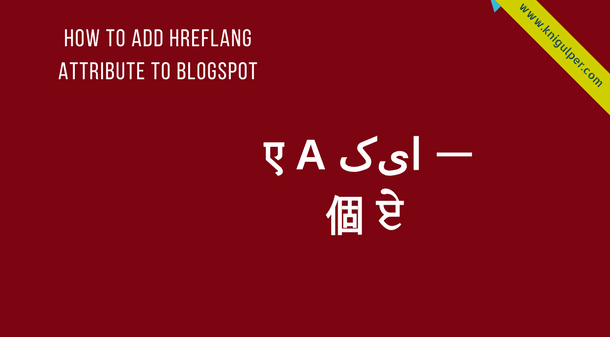Technically, with rel="alternate" hreflang="x" attribute, you specify the language of a web page in the eyes of search engines. By adding hreflang annotations to your Blogger templates, you are helping search engines like Google and Yandex serve the right language for a regional searcher. Occasionally, Hreflang annotations may be difficult to implement and often occurs a number of errors in Google search console. Here's an easy guide how to make your hreflang work in one straight method.

Let's suppose there are two similar topics on the web one is written in Hindi language and another is written in the Urdu language. Therefore, when a searcher types the topic on Google and Yandex, they shows search results based on the searcher's location. So, when you apply hreflang to your HTML page, the searcher discover your content in SERP based on his regional language with the help of hreflang attribute you added.
Read Also: How To Add Ads.txt File To Blogger
An improper implementation of hreflang tag may cause conflict in the search console. You might have seen dozens of hreflang conflicts in search console under the international targeting. This is due to improper hreflang implementation that returns to homepage only.
When adding the hreflang to BlogSpot template, keep in mind that HTML hreflang tag may cause the conflicts because they do not work the way we add them. So how should you add the hreflang annotation? Simple, add XML format with data tags.
Steps to Add Hreflang Tag:
- Sign in to your Blogger dashboard > Theme > Edit HTML
- Just below <head> add the given hreflang attribute
- And finally, save your changes
<link expr:href='data:blog.url' hreflang='x-default' rel='alternate'/>
The Hreflang='x-default adds a signal to search engines that a user querying in language "a" will want this result instead of a page with similar content in language "b". You can add Hreflang='x-default tag when you think that you do not want to serve for a specific language.
If you have contents in other languages such as Hindi, Urdu, Chinese, or have multilingual pages, you can specify the content language by replacing the x-default with ISO language code. Wrong language code does not make sense for both search engines and searchers.
Have a look at the following Hreflang tags:
<link expr:href='data:blog.url' hreflang='en' rel='alternate'/> specifies the English language
<link expr:href='data:blog.url' hreflang='en-us' rel='alternate'/> specifies the United States English language
<link expr:href='data:blog.url' hreflang='hi' rel='alternate'/> specifies the Hindi language
<link expr:href='data:blog.url' hreflang='zh' rel='alternate'/> specifies the Chinese language
<link expr:href='data:blog.url' hreflang='ur' rel='alternate'/> specifies the Udru language
Read complete ISO Language Codes on W3schools
Impacts Of Hreflang On SEO
- It helps you to optimize your pages for users language and location
- By adding hreflang you adds a signal to the search engine that it’s the same content, just optimized for different language and location
- If you have the same content in two different languages on different URLs, it prevents the problem of duplicate content
Have any question, suggestion or feedback regarding this post? Feel free to post your valuable comments.





![How to Create Separate AMP Pages On Blogger [AMP Plugin] How to Create Separate AMP Pages On Blogger [AMP Plugin]](https://3.bp.blogspot.com/-7_Zi0gwDfBg/Wv_KUWb2x6I/AAAAAAAADSs/0g9v_s3NqIkQIBfiq9v8iYSpgvp4RebIACLcBGAs/s72-c/AMP-plugin-for-blogger.png)
Very Nice Post brohter
ReplyDeleteThanks bro! Keep visiting
DeleteHello brother blog template me meta tag dekhe yar page view source se.... Kya problem hai
ReplyDeleteEverything is good! No need to edit your theme. Just install hreflang tag to your HEAD section.
Delete